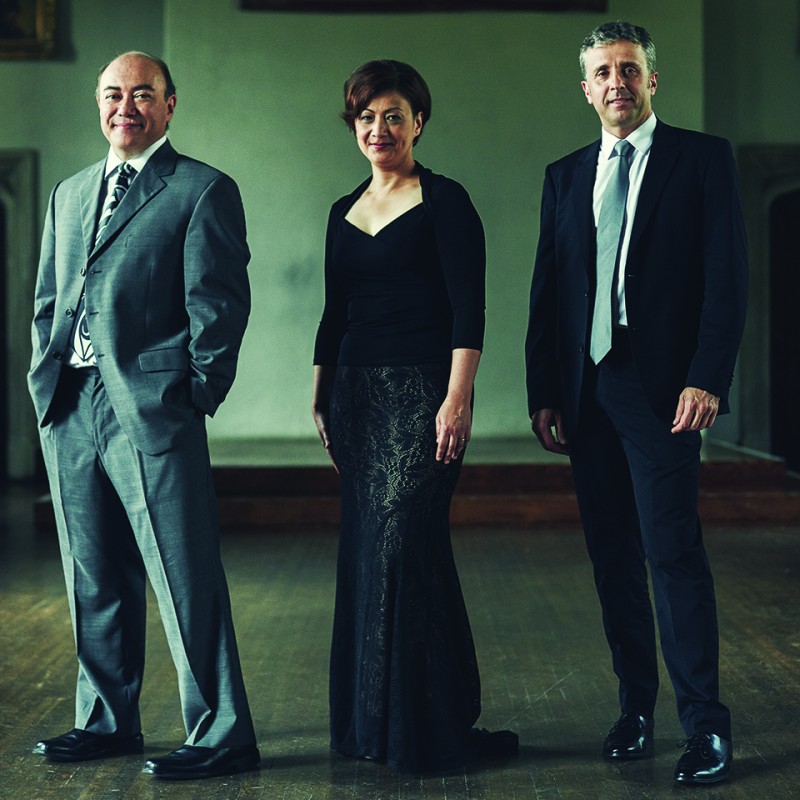
The Gryphon Trio, a Canadian threesome that played the Flagler Museum music series in 2006, returned Feb. 5 to Whitehall with three works from the Austro-German canon.
Violinist Annalee Patipatanakoon, cellist Roman Borys and pianist Jamie Parker offered music by Haydn, Beethoven and Brahms, playing the trios in chronological order, with Parker commenting as they went about how the three composers had expanded the form in their turn. It was an evening of excellent music, beautifully played and presented, and none the less rewarding for being a program of standards.
Truth to tell, the Haydn trio that opened the concert, No. 45 (in E-flat, Hob: XV, 29), is not as well-known as it should be. One of the composer’s last essays in this form, it features a part for the piano that largely subordinates the violin and cello. It’s mature, rich Haydn, full of that positive radiance and sly wit that distinguishes so much of his music.
Pianist Parker was in the spotlight here, with a showy piano part full of cascading scales and bubbling arpeggios. Nevertheless, violinist Patipatanakoon and cellist Borys made the most of their accompaniment roles, enriching the texture and, in moments such as the minor-key variation in the first movement and the lovely main theme of the second movement, hinting at what might have been had Haydn taken another step into the future and written a different kind of trio.
But that task was left to younger men such as Beethoven, who in his Piano Trio No. 5 (in E-flat, Op. 70, No. 2), written scarcely more than a decade after the Haydn, moves in a different world. This powerful masterwork starts almost imperceptibly on just violin and cello before being joined by the piano, and then expands into one of those Beethovenian movements in which the explosive material threatens to burst the bounds of the structure.
This piece was written at the same time as the Fifth and Sixth symphonies, and the three players showed themselves more than adequate to the challenge of this dramatic music. They also showed how tight they are as a performing unit, having played together for more than 25 years and with 15 recordings under their collective belt. There was no question about the security of their blend or how well they communicate with each other.
Like a lot of Beethoven’s most widely varied music, this trio often gets a dramatically extravagant reading, but the Gryphons kept things classic and straightforward without losing the element of surprise. Tempos were generally light and speedy except for the Allegretto second movement, which gave the overall arc of the work a sense of drive and magnitude. The Beethoven also afforded the sizable house Tuesday a chance to really appreciate Patipatanakoon’s light, sinewy playing and the lovely tone Borys regularly produces from his cello.
The second half was devoted to the Piano Trio No. 2 (in C, Op. 87) of Brahms, one of his finest pieces of chamber music. This was the best performance of the night, an absorbing rendition of a small-forces work with symphonic scope in which the Gryphons were fully engaged.
Maybe it was something about the propulsiveness of the opening theme that makes it fun to play, but whatever it was the Gryphons dug into it with gusto, sounding liberated from the strictures of the earlier music and able to let things rip. After the excitement of the first movement, the next two models of sharp contrast: the second sounded intensely mournful, and the third darkly mysterious, aided by a fast tempo and hushed dynamic level, relieved by the warmth of the trio section.
The finale sounded big and generous, and the three kept the balance admirably well given the resonance of the Whitehall music room (in this they were aided by Lily Flagler’s 1903 Steinway, which is more modest than today’s concert grands and better suited to the venue); Parker in particular made sure not to overwhelm his partners with Brahms’s thick, exuberant textures.
The trio added an encore: Astor Piazzolla’s La Muerte del Angel, and played this convulsive tango with even more intensity than the Brahms, winning fervent applause from the audience. This was a good night of chamber music, in which fine music was played in stellar style by three veteran musicians whose immersion in this repertoire is clearly demonstrated in every measure.